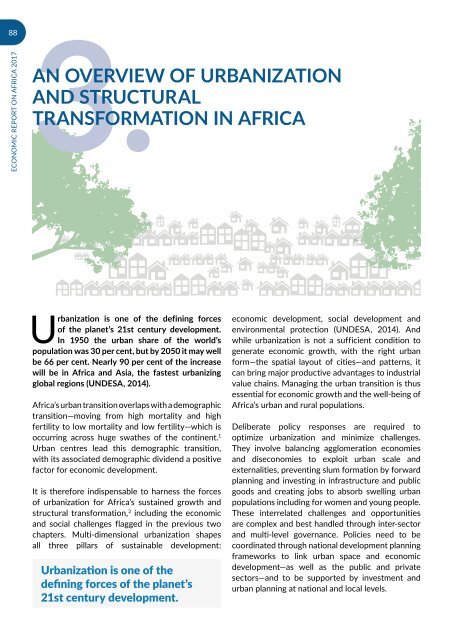URBANIZATION AND INDUSTRIALIZATION
Economic%20Report%20on%20Africa%202017%20UNECA
Economic%20Report%20on%20Africa%202017%20UNECA
Create successful ePaper yourself
Turn your PDF publications into a flip-book with our unique Google optimized e-Paper software.
88<br />
ECONOMIC REPORT ON AFRICA 2017<br />
3.<br />
AN OVERVIEW OF <strong>URBANIZATION</strong><br />
<strong>AND</strong> STRUCTURAL<br />
TRANSFORMATION IN AFRICA<br />
Urbanization is one of the defining forces<br />
of the planet’s 21st century development.<br />
In 1950 the urban share of the world’s<br />
population was 30 per cent, but by 2050 it may well<br />
be 66 per cent. Nearly 90 per cent of the increase<br />
will be in Africa and Asia, the fastest urbanizing<br />
global regions (UNDESA, 2014).<br />
Africa’s urban transition overlaps with a demographic<br />
transition—moving from high mortality and high<br />
fertility to low mortality and low fertility—which is<br />
occurring across huge swathes of the continent. 1<br />
Urban centres lead this demographic transition,<br />
with its associated demographic dividend a positive<br />
factor for economic development.<br />
It is therefore indispensable to harness the forces<br />
of urbanization for Africa’s sustained growth and<br />
structural transformation, 2 including the economic<br />
and social challenges flagged in the previous two<br />
chapters. Multi-dimensional urbanization shapes<br />
all three pillars of sustainable development:<br />
Urbanization is one of the<br />
defining forces of the planet’s<br />
21st century development.<br />
economic development, social development and<br />
environmental protection (UNDESA, 2014). And<br />
while urbanization is not a sufficient condition to<br />
generate economic growth, with the right urban<br />
form—the spatial layout of cities—and patterns, it<br />
can bring major productive advantages to industrial<br />
value chains. Managing the urban transition is thus<br />
essential for economic growth and the well-being of<br />
Africa’s urban and rural populations.<br />
Deliberate policy responses are required to<br />
optimize urbanization and minimize challenges.<br />
They involve balancing agglomeration economies<br />
and diseconomies to exploit urban scale and<br />
externalities, preventing slum formation by forward<br />
planning and investing in infrastructure and public<br />
goods and creating jobs to absorb swelling urban<br />
populations including for women and young people.<br />
These interrelated challenges and opportunities<br />
are complex and best handled through inter-sector<br />
and multi-level governance. Policies need to be<br />
coordinated through national development planning<br />
frameworks to link urban space and economic<br />
development—as well as the public and private<br />
sectors—and to be supported by investment and<br />
urban planning at national and local levels.


